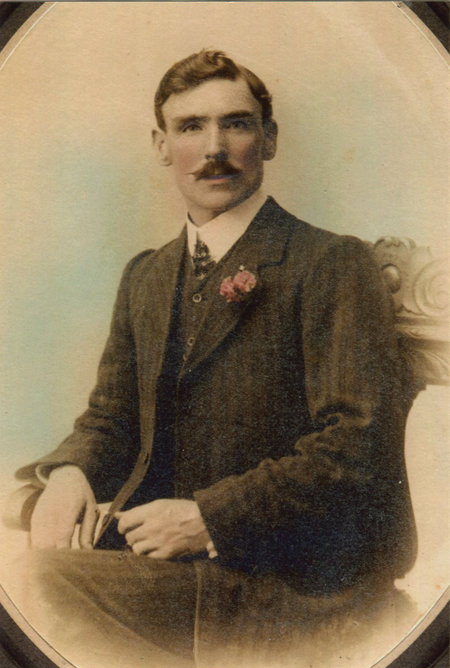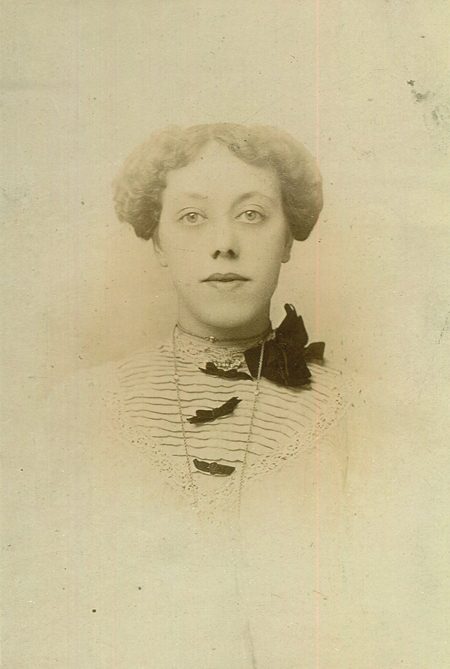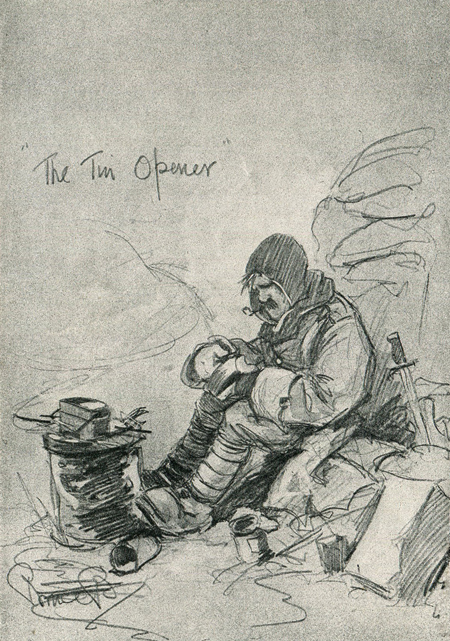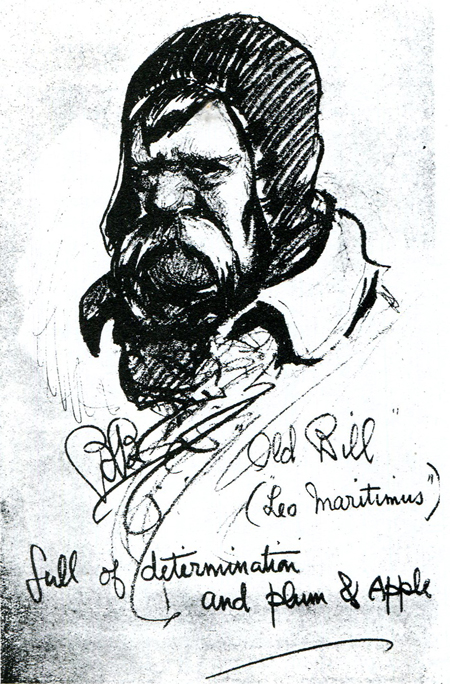In Search of ‘Old Bill’: Western Front Association Article
The following article was first published in The Western Front Association Bulletin 125, September 2023. Essentially it is a synopsis of John Belcher’s book In Search of Old Bill, published by Brewin Books Ltd in late 2022, and which I edited. It also contains some additional thoughts regarding the depiction of Thomas Rafferty, as drawn by Captain Bruce Bairnsfather. Anyone with additional information relating to Thomas Rafferty should feel free to get in touch.
During the winter of 2020 / 2021 I was approached by John Belcher to ask if I would be interested in editing together his years of research concerning his great Uncle, Thomas Rafferty, (Ill.1), who had fought in World War One, and died at the second battle of Ypres. Having a wide-ranging interest in history I was immediately intrigued by the topic, and this was to become my ‘lock-down’ project. John had come into possession of an archive of material from Rafferty’s daughter, Ivy, which had been passed down to her by her mother – and Thomas’s wife – Kate, (Ill.2). One of the most intriguing aspects of the archive was the indication that Rafferty may actually have been closely associated with Captain Bruce Bairnsfather, and indeed, had been the inspiration for the creation of his famous cartoon character ‘Old Bill’. There had been an ongoing debate within Bairnsfather’s lifetime as to whether – and whom – had been the original ‘Old Bill’. When asked, Bairnsfather had simply stated that he was depicting a ‘type’ of soldier rather than a specific individual. However, the evidence within the archive demonstrating that Rafferty was indeed the inspiration for Bairnsfather’s ‘Old Bill’ would subsequently appear to be unequivocal, but in another sense what emerges from the archive is much more interesting.
The book’s primary aim, therefore, was to lay out the evidence within the archive and thereby demonstrate that Rafferty was in fact the inspiration for Bairnsfather’s creation of ‘Old Bill’. Beyond this, however, it was also intended to give a flavour of who Rafferty was as a person, and also explore the quite extraordinary story that unfolded as we read and digested all the various documents and photographs that made up the archive.
Rafferty was a reservist with the Royal Warwickshire Regiment who at the start of the war in 1914 was working with the Birmingham tramways. As such, he served with the British Expeditionary Force that become known as The Old Contemptibles who would become regarded as experienced hands, particularly when contrasted with the many men that would volunteer. Indeed, the idiosyncratic personality of the ‘old soldier’ is something that Captain Bairnsfather would always refer to as part of their appeal. In late 1914 it is apparent that Rafferty was serving with Bairnsfather in the Ploegsteert Woods area of the Ypres salient, but whilst Bairnsfather would survive the subsequent Second Battle of Ypres, Rafferty would unfortunately be killed.
Intriguingly, a significant piece of evidence within the archive was a letter from Bairnsfather, written by his secretary, in response to a letter from Kate Rafferty enquiring as to the well-being of her husband. It would make sense that Kate sent this letter soon after the Second battle of Ypres, (April 1915), and though she did not yet know it, this was the battle within which Rafferty had been killed. In sending the letter she was presumably familiar with Bairnsfather’s work appearing within the press of the day, and had established a link between Bairnsfather and her husband from his diaries. Within the letter, reference is made to a photograph which Kate had presumably included to aid identification of Rafferty, and asking if he was known to Bairnsfather as ‘Old Bill’, (Ill.3). However, whilst Bairnsfather expresses regret for her situation, he then denies that Rafferty was known to him as ‘Old Bill’, instead identifying one of his companions, in an apparent act of deliberate misdirection. This claim, however, can be discounted on the basis of a newspaper article dated August 1917 written by Bairnsfather himself and uncovered by John Belcher, at the British Library News desk in 2015. Within The Weekly Dispatch he includes a photograph of Thomas Rafferty and his companions, which is, strikingly, the same photograph to be found in our archive and presumably the one that Kate sent to Bairnsfather two years previously.
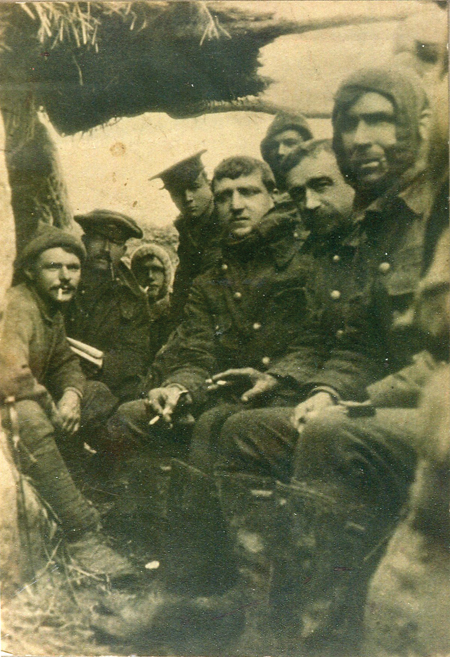
Beneath the image of Rafferty Bairnsfather specifically names him as ‘Old Bill’. Why does he do this, thereby contradicting his earlier claim to Kate that he did not really know Rafferty? It would seem that Bairnsfather was stung into publication of the article because of criticism he was receiving within the Houses of Parliament from those who felt his depiction of the common soldier as an uncouth and shabbily dressed individual, as embodied in ‘Old Bill’, was actually quite disrespectful. In publishing the photograph Bairnsfather was demonstrating that his depiction of ‘Old Bill’ was simply a reflection of his lived reality. To quote from the article: “I have invented nothing. This photograph I took in Plug-street Wood in 1914, and here you see for the first time the originals of Old Bill, Bert, and Alf as I knew them and portrayed them.” In his own words, then, and with reference to what has become known as the ‘Plug-street Wood photograph’ Bairnsfather identifies Rafferty as ‘Old Bill’.
In a sense, this let the ‘genie out of the bottle’, as the figure that Bairnsfather named as ‘Old Bill’ was immediately recognised as Thomas Rafferty, and two newspaper articles – that Kate had kept – were to follow. The first of these was the The Weekly Dispatch with the article ‘The Weekly Dispatch Discovers The Original of ‘Old Bill’’.
The second was the Birmingham Daily Mail, publishing the article ‘‘OLD BILL’ Handsworth Original Of Bairnsfather Hero’. Both of these would reinforce Rafferty’s claim to be ‘Old Bill’, so in a sense it is surprising that Rafferty did not become established in the mind of the wider public as such.
This fading from public prominence might have been very different if a proposed film had eventually been made. Also within the archive were a series of letters demonstrating that Kate Rafferty had been in discussion with a film company, Uneeda films, who were interested in making a production focusing on what Kate could tell them of Rafferty as the embodiment of ‘Old Bill’. This had progressed to the stage where a contract had been drawn up, with Kate apparently passing on Rafferty’s diaries. This was especially unfortunate since the film agent, a Mr Smith, would subsequently travel to America, never to return. This of course meant that Rafferty’s diaries were also lost, which must have been particularly excruciating for Kate. Not only did these diaries hold an enormous sentimental value, but were further evidence that Thomas was indeed the original ‘Old Bill’. It is apparent that Kate went on to contact Horatio Bottomley, the editor of John Bull, a popular magazine of the time to see if he could locate Mr Smith and the diaries, but to no end.
The one consolation that Kate could hang on to was that before he disappeared Mr Smith arranged that she should appear on stage at the Manchester Palladium where she was indeed acknowledged as the wife of Old Bill following a showing of the film ‘The Better ‘Ole’ based on the life of ‘Old Bill’. It seems probable, also, that it was here she was presented with a Peace Medal which also made up the archive. It seems that, despite having lost her husband, and having been dismissed by Bairnsfather, she would ultimately be embraced by a loving public who accepted her as the wife of ‘Old Bill’, (Ill.4).
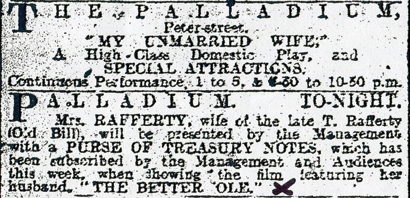
Within the archive, we are fortunate to have several good quality photographs of Rafferty, in civilian clothes, dress uniform and combat uniform: all of these give us a clear impression of Rafferty’s facial features, (Ill. 1, 5 & 6). Mirroring this, amongst Bairnsfather’s earlier works we have identified at least three images – and there may yet be more – where it is possible to identify Thomas Rafferty as the basis for the character portrayed in Bairnsfather’s drawings.
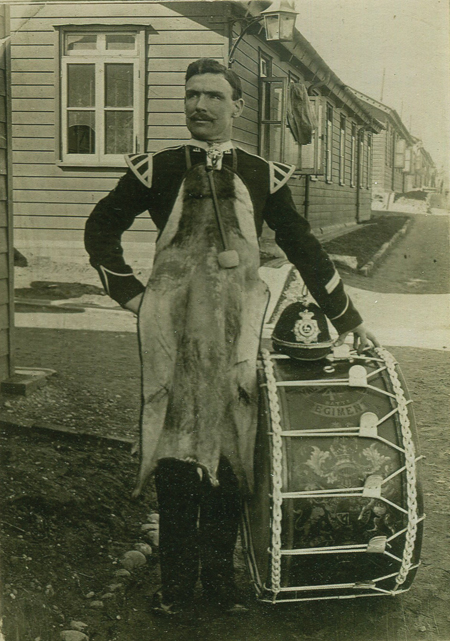
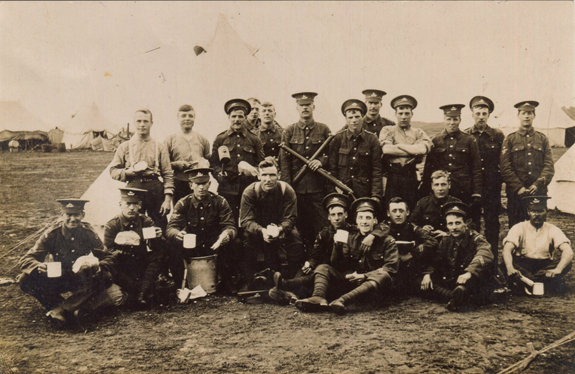
A sketch by Bairnsfather, probably from 1915 ‘The Tin Opener’, (Ill.7), shows a rather unkempt soldier with moustache and pipe hanging from his mouth pre-occupied with prising open his rations. Whilst in this image we cannot make out facial characteristics there is a striking similarity between this figure and our ‘Plug-Street Wood photograph’.
Bairnsfather’s most famous image, and since it was created in 1915 also one of his earliest, is of ‘The Better ‘Ole’, so called because of it’s caption: ‘Well, if you knows of a better ole, go to it!’(Ill.8). Here, we see two soldiers stranded within a shell-hole remonstrating with each other about the absurdity of their predicament with a stoic humour. Whilst ‘Old Bill’ became synonymous with his ‘Better ‘Ole’, at this stage Bairnsfather had not named his character as such, but note the facial similarity of the character on the right to the photographs of Rafferty.
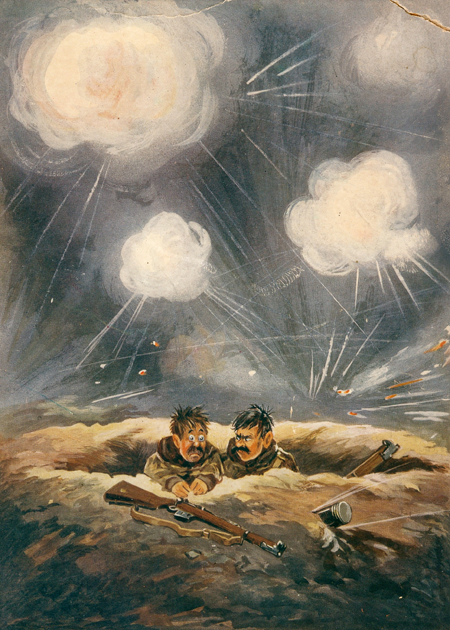
This same character appears again, with much greater clarity, in another image, ‘The Eternal Question…When the ‘ell is it going to be strawberry?’, (Ill.9). To my mind, this is the closest Bairnsfather comes to providing us with a visual portrait of Rafferty: the facial characteristics being strikingly similar to his surviving photographs.
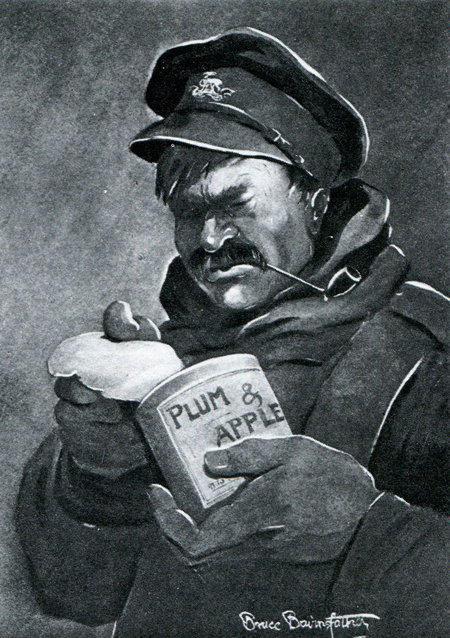
Again, at this stage, we should remember that the character depicted in these images was not named as ‘Old Bill’, so this theoretically weakens the link with Rafferty, but what strengthens the link is that Bairnsfather appeared to be modelling his own drawings specifically on Rafferty himself, and we earlier established that he was known to Bairnsfather as ‘Old Bill’.
Over the course of editing the book it has occurred to me that it is possible to track the ‘evolution’ of ‘Old Bill’ from a character who looks remarkably like Thomas Rafferty, to a much more generic cartoonish figure.
In this sense, the ‘form’ of ‘Old Bill’ evolved more exaggerated features: the moustache became bushier, the cheeks rosier, the features older and more rounded, (Ill.10). Indeed, within the space of several months, ‘Old Bill’ would no longer be tied to an identifiable face but instead become a ruddy, rotund character with smiling eyes – a ‘Falstaffian’ figure whose primary concern is his next meal and rum ration – the form of which is echoed in countless images of Father Christmas, another beloved ‘type’. Bairnsfather would continue to portray ‘Old Bill’ in this finalised form for the rest of his life, (Ill.11).
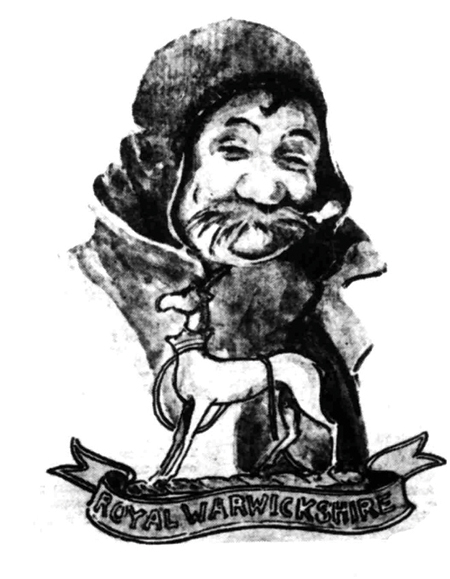
No doubt, this change occurred for a variety of reasons: there is an inherent comedic value in such a simplistic character that cannot be denied, and one should not discount the practical application of being able to draw a character with a few rapid strokes of a brush when there is a deadline to meet! It should also be noted, however, that Bairnsfather may well have been wary of depicting a character who so closely resembled Rafferty, and could therefore be identified as such: we must remember that Bairnsfather had specifically denied to Rafferty’s wife Kate that he had not known Thomas Rafferty as ‘Old Bill’, and in simplifying his cartoon creation it would lose any features that could identify Rafferty as the original source. This approach was possibly a two-edged sword: throughout his career Bairnsfather would continue to be contacted by many personalities who would claim to be the original ‘Old Bill’, so whilst the cartoon could not be tied to one particular individual, it could subsequently be claimed by many more.
The publication of this book represents a triumph of the work done by one amateur researcher over many years. There are countless researchers such as John who tirelessly sift through the records of their chosen field simply because they have a compulsion to do so, something generously acknowledged by Carl Chinn within his foreword. I hope that, in assisting with the editing of his book, I have helped to shine a light on what would otherwise have remained a forgotten corner of history. I also hope the book In Search of Old Bill will offer encouragement to others who have accumulated research that would benefit a wider audience, but have yet to gather the confidence to publish their own work. Afficionados of Bairnsfather’s work will note that the title In Search of Old Bill echoes the title of the Holt’s biography of Bruce Bairnsfather, In Search of the Better ‘Ole. This was a conscious decision, intended as a tribute to their own research which I have drawn upon, but it also alludes to the long debate surrounding the identity of ‘Old Bill’. Now, with the publication of our book that identifies Thomas Rafferty as the original ‘Old Bill’ we hope that the search can finally be concluded.
Thomas Small & John Belcher 2023

